New Beginnings
The Years of Transformation With The Celtic Connection
By MAURA DE FREITAS
VANCOUVER – When I launched the first issue of The Celtic Connection along with my mother Catholine Butler in 1991, it was a vastly different time. So much so that over the past three decades the entire landscape of the publishing industry — in fact the world of communications — has completely transformed.
To begin with the Internet was in its infancy, cell phones were rare, social media unheard of, digital cameras had yet to be invented, and almost every device was analog. Everything required a lot more legwork, but it also seemed that things were a lot more informal. You could pick up the phone and people actually answered. In addition, the production of a newspaper was vastly different.
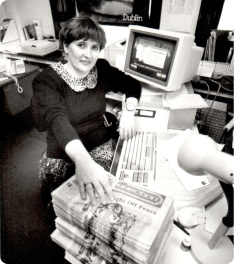
MAURA DE FREITAS [McCay] at work in the office at The Celtic Connection [circa 1993].
Final layout followed a long cycle of advance preparation including generating content, editing and proofing, covering events, taking photographs, chasing advertisers, collecting receivables….all the while paddling just to stay afloat and keep our heads above water.
It was a never-ending round of running, chasing, haggling, extracting, producing (with just a few wars in between), and then deliveries.
There was always that brief moment of satisfaction when the issue was finally printed. To feel the rush of relief when we opened that paper and knew that it was complete for another month.
People would say with the kindest intention: “Well, now you can rest for another month.” If only they knew! We could only laugh. It was just the briefest interlude before the madness started all over again.
And yet there was that drive, the allure, the downright satisfaction of producing something that gave voice to so many. There was always a sense that our dance card had an expiry date and we were creating a snapshot of a generation.
It was an era where the community was fairly tight knit with lots of dances, concerts and social activities. It was a time when everyone knew everyone else. They might not even be speaking to them but they knew them all the same….and everyone was in the same boat (away from home and missing loved ones!).
Throughout the journey we have been blessed with a legion of supporters, people who arrived just at that very moment we needed them most with offers of assistance.
In fact my mother joked that if you walked in the door just to say hello it was at your own peril because more often than not you were immediately drafted into service.
No experience you say? No problem. You can learn on the job. Here’s a list, we need a stack of papers delivered. And, you know what? So many came back month-after-month to help out in whatever way they could. It was a miracle.
Those angels (and they know who they are) would almost seem to appear out of the nether, often in what we believed was our darkest hour and we couldn’t see a way forward.
One of those remarkable people was Jack Wallace. He took me under his wing and became my mentor and guide before we even launched the first issue. Little did I know what I was actually undertaking.
In hindsight, my lack of understanding was probably my saving grace because anyone knowing the full scope of what would be required wouldn’t even have ventured the first step.
Jack was an old hand in the business. It was in his blood. His father and his grandfather before him were journalists on the beat and both had lived and died the daily grind of press deadlines.
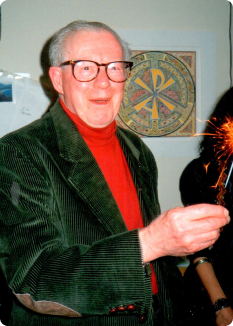
JACK WALLACE at a celebration for The Celtic Connection in 1994.
Sadly his father succumbed to alcoholism — the same disease that haunted so many literary souls of that generation — when Jack was still just a young boy of 12 years old.
He was immediately offered a job in the same newsroom where his father had worked and he began to learn his trade. He remained a lifelong avowed teetotaler knowing only too well the pitfalls of the industry.
Jack worked in New York and San Francisco with some of the most renowned luminaries in the business, including Walter Winchell and William Randolph Hearst. He travelled throughout the United States with the Hearst Corporation. His talent was redesigning newspapers that needed new life to survive — creating a fresh look to thrive in a cut-throat industry. In fact, he became known throughout the industry as ‘the newspaper doctor’.
When we met in the early ‘90s Jack was retired. A mutual friend mentioned to him that she knew someone planning to launch a newspaper geared specifically for the Celtic people and his ears had perked up. He informed me that he was inspired by the great William Wallace and identified strongly with his Scottish heritage. He came to Canada when he was contracted to do a major redesign of the Vancouver Sun newspaper to help mark Expo ‘86.
Born and raised in New York City, Jack never found the need to learn how to drive as he was accustomed to taking taxis from one destination to the next. In Vancouver his devoted wife Jan was his designated chauffeur. He was the most fascinating and eccentric character, twinkling blue eyes, with a little black beret perched on the side of his head — definitely from another era. In more lighthearted moments he would regale us with stories of his wild and crazy days in the media industry but when he was working he was deadly serious.
After the first issue it began to dawn on me just how much intense energy was actually involved to maintain the pace. Jack steadied me and helped to keep me focused. It was with his help that I started to understand what I needed to learn before I could fly on my own.
But I will never forget that feeling when I delivered that first printing down to the old Irish Centre on Prior Street. The bundles were snapped up and as I looked across the room all I could see were faces buried in the first edition. It was quite intoxicating. After working so many hours through blood and sweat, to see people actually cracking open the pages and reading the content just about made me swoon. I was hooked.
We established offices in a heritage building on Hastings Street in downtown Vancouver and in those early days it was a hive of activity. In fact, it was the epicenter of the Celtic storm with people dropping by to say hello, phones ringing, and all manner of advice and suggestions coming our way. Production meant long nights with little or no sleep, sometimes for days on end, to meet our deadlines. It was a domino effect and coordinating all the pieces was exhausting.
One day Professor Robert O’Driscoll who established the Chair of Celtic Studies at St. Michael’s College with the University of Toronto called to offer congratulations on the new paper. I thanked him for his kind words as he commented on the professional layout and design but I told him “truthfully it’s chaos and God only knows how long we can survive.”
His words made a deep impression. He said: “Maura from your perspective at the centre of the storm it might feel like chaos, but the further back you stand and look it’s a beautiful creation. Don’t despair, don’t give up. Persevere it gets better.”
He gave me hope that The Celtic Connection was indeed reaching people and it resonated for them. That’s all I could ask for.
Marie Bruce was another delightful soul who arrived one day to offer herself as a volunteer.
She was immediately assigned to answer phones and chase money of which we were very much in need (a chronic condition which never really seemed to be resolved).
One day I arrived in to learn from Marie that I was going to New York City to accept an award as one of the ‘Top 100 Irish-Americans of 1993’ for my work on the paper.
I thought surely someone is pulling my leg but no, it was the truth.
My immediate response was “there’s absolutely no way I can go to New York, I can’t even afford to go around the corner right now, and besides the fact I’ve got a newspaper to publish.”
With her usual practical, down-to-earth advice, Marie dismissed my misgivings and said, “Of course you’re going to New York Maura, you’re not going to miss this opportunity!”
And somehow, before I knew it, there I was at the Plaza Hotel right across from Central Park in New York rubbing shoulders with the bourgeoisie and meeting people that I could once only have dreamed of encountering.
All I could do was laugh at the absurdity of it all. First of all, I really doubted that I even qualified for the honour and secondly, I could just about hear the pennies jingling in my pocket.
But it was great fun all the same and I met some of the most amazing people — some lifelong friends — as a result.
One very fortunate connection was the head of Aer Lingus in New York who offered a contra deal to The Celtic Connection.
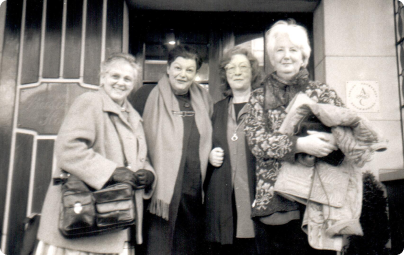
ELINORE DETIGER [second from left] pictured on the front steps of Buswell’s in Dublin along with [L-R] Isabelle Smyth, Gillian Kean, and Annabelle Watson at the Global Women’s Network conference in February 1994.
Seemed like a great idea to me and it allowed me to travel — again on a wing and a prayer — back and forth to Ireland via New York several times a year. My father had moved back home to Ireland so it suited me very well.
Another serendipitous encounter was meeting Elinore Detiger. She was a mysterious wealthy philanthropist who travelled the world bringing together people working at a grassroots level to help promote unity and peace in the world.
Along with helping so many others, she was there for us in so many ways, never making demands or requests of any kind, just merely stepping forward to assist and support when we needed her the most.
She was introduced through another friend, author Charles Ferris who had written a book called: ‘Angels of Mercy: A Dream of Peace for Ireland’.
Elinore invited me to Ireland on a number of occasions, once for an all-expenses paid trip to The Global Women’s Network conference at Buswells Hotel in the heart of Dublin.
Located just a stone’s throw from Leinster House, Buswells is a hugely popular meeting place for Irish politicians and is commonly known as ‘the third house of the Oireachtas’.
This global gathering was an incredible experience. It allowed me to meet women from around the world, from all walks of life, rich and poor, who came together to share and learn how to network for a better world. It was refreshing and enlightening.
On another occasion, just when I thought I was at the end of the road, Elinore swooped into town and whisked me away to the sacred isle of Iona off the west coast of Scotland.
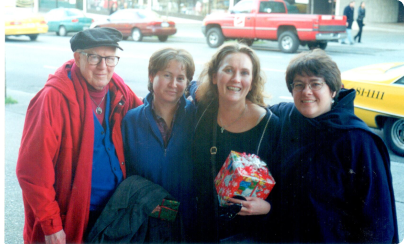
EDITORIAL STAFF working on The Celtic Connection at Christmas 1999 [L-R] Jack Wallace, Alicia Martin, Maura De Freitas, Andrea Law.
Along about this time, a conspiracy of sorts took place.
A year earlier Tom Butler had lost his beloved wife to cancer and it was a great sorrow for him and his family.
Tom was a proud Mayo man. He was one of the founding members of the Vancouver Irish Sporting and Social Club (ISSC) and a stalwart club supporter. He was also known over the years in the Irish community for hosting great house parties where people sang and danced into the early morning hours. His door was always open to his fellow countrymen and women with many finding a start in a new country and a new city as guests at the Butler residence. For this reason Tom had a great many friends who were concerned about his well-being and hoping that he could move on with his life.
I mentioned earlier about all the social events we attended in this period, and my mother who was single was often seated beside Tom for company. It didn’t go unnoticed that when they were together there was a lot of laughter and they seemed to get along like a house on fire.
So began a plot to bring those two together — a marriage so to speak of the ISSC and The Celtic Connection.
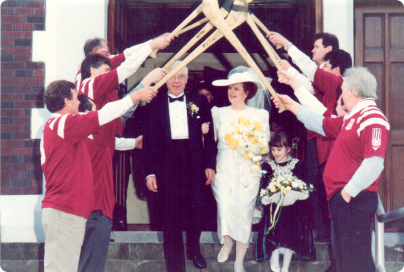
TOM AND CATHOLINE Butler’s 1995 wedding was a marriage of the Vancouver Irish Sporting and Social Club and The Celtic Connection.
There were multiple perpetrators in the plot with the ultimate goal of seeing two people happy….and so it came to be. A massive house party was held at Tom Butler’s following the wedding vows at St. Augustine’s Parish in front of Father Mohan. And a new chapter had begun.
Tom treated me as another daughter and he took it upon himself to look out for me. We formed a very close bond built on mutual respect. He was very proud of our work on The Celtic Connection but he was one of my greatest supporters.

CATHOLINE BUTLER in the Vancouver St. Patrick’s Day Parade as Irish Woman of the Year.
I can now look back and reflect what a very long distance we have come from those early heady days. We have grown into our identity and became stronger thanks to those challenges.
Along the way we made countless friends and I firmly believe we served our diverse Celtic community to the best of our ability. We put our heart and soul into the project and helped bring together pan-Celtic groups across Western Canada and the U.S. Pacific Northwest. In doing so, we gave voice to hundreds if not thousands in a very unique way. Some of our proudest moments have been the celebrations and community support for our work over the years.
I was particularly thrilled when my mother was presented with the Lifetime Spirit Award by the Vancouver Irish Sporting and Social Club. That was a wonderful night of bon ami. She was also presented with an award by a Canadian prime minister, on behalf of the National Ethnic Press and Media Council of Canada. It acknowledged the role of The Celtic Connection in promoting equality, respect to human values and human rights. And for co-operation and understanding among the members of the various cultural groups of Canadian society.
Another highlight was when the Men’s Western Canada GAA Championship Cup was named the Tom Butler Cup. It gave us tremendous joy to see his many years of volunteer work recognized in that way.
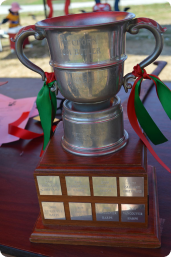
TWO Western Canada GAA Championship Cups: (L) The Tom Gibbons Women’s Championship Cup and (R) The Tom Butler Men’s Championship Cup.
Shortly after the launch of The Celtic Connection the Irish Women’s Network (IWN) was formed by Mary Hatch who was inspired by the election of Mary Robinson, the first woman to hold the office of President of Ireland. It was her gesture of placing a candle in the window of Áras an Uachtaráin to welcome home the souls of the diaspora that particularly spoke to Irish scattered throughout the world.
The IWN has been an outstanding friend and both Catholine and myself were each honoured with the Irish Woman of the Year award on various years and that was a great boost for all of us working on the paper.
There have been so many changes over the years and it was a great privilege to be present to witness and to record many of those developments.
In 2018 the new Consulate General of Ireland was established in Vancouver thanks to a huge influx of young Irish migrants following the collapse of the Celtic Tiger a decade earlier. This was the first new Irish diplomatic mission to open in Canada since the Embassy of Ireland opened in Ottawa in 1939.
Frank Flood and his wonderful team have brought new vitality and cohesiveness in a growing and dynamic community. In this current time of personal and economic challenges for so many, their support and resourcefulness has been an immense asset.
Now, as we emerge at the end of our journey in publishing a print edition of The Celtic Connection, it’s remarkable to reflect on how the local Irish community has also transformed. From our perspective, we’ve also evolved and grown – no longer caterpillars, it’s time to soar on our own wings.
What the future brings we can only imagine but whatever it does the gifts of working with the various Celtic communities across western Canada and the U.S. Pacific Northwest for almost 30 years have been priceless.
Sending love and best wishes to all of you who have stood in solidarity with us through the storms. You’re the rock that supported us. This is a new day and a new beginning. May blessings be upon you.
Maura x
Maura De Freitas
Editor/Publisher
The Celtic Connection
POSTSCRIPT: I would be remiss if I did not mention the key role that my mother Catholine Butler played in publishing The Celtic Connection. Not only did she handle advertising sales and promotions, she also managed distribution of the paper each month. In addition, she wrote articles, travelled throughout western Canada and the Pacific Northwest to interview countless personalities, and generally worked to help create an historical archive of the period 1991-2020. She also served as the public relations core of the newspaper and helped smooth out the edges at times when I might have been considered a little less than diplomatic. The Celtic Connection would never have survived without her support.